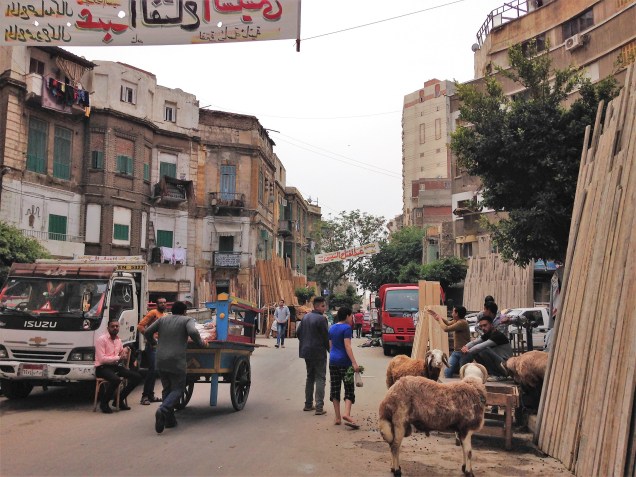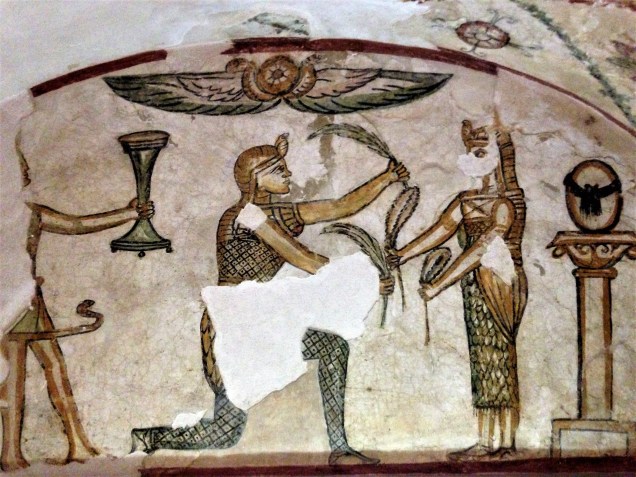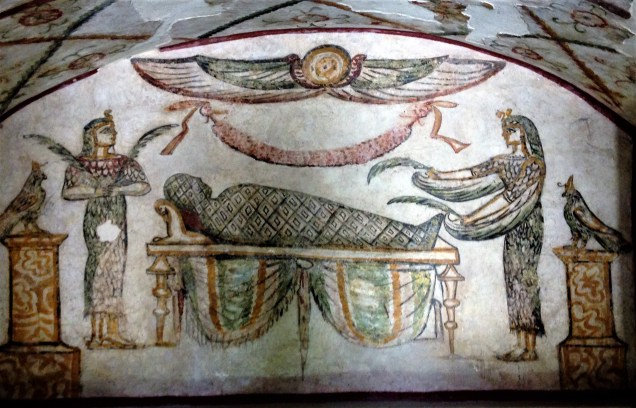 Alexandria is an interesting city, full of history from ancient times and forward. A lot of what we want to see is very walkable – an hour or less from our hotel. Today we walked through a series of interesting neighborhoods to the catacombs of Kom al Shoqafa, a tomb complex dug deep into the ground – so deep that the bottom level is now underwater.
Alexandria is an interesting city, full of history from ancient times and forward. A lot of what we want to see is very walkable – an hour or less from our hotel. Today we walked through a series of interesting neighborhoods to the catacombs of Kom al Shoqafa, a tomb complex dug deep into the ground – so deep that the bottom level is now underwater.

It’s an eerie experience heading down the spiral staircase so deep into the earth; the air changes, and the lighting inside the tombs creates interesting effects.
The tombs were used between the second and fourth centuries CE, and the art combines all kinds of elements: traditional ancient Egyptian gods and other iconography of the afterlife; Roman laurel crowns and decorative elements; and Greek-influenced depictions of human figures.

The effect is almost more kitschy than impressive, both in the underground tombs and the two aboveground tombs, which still have some of their original bright paint.




I’m wondering if the aboveground tombs were somehow “rescued” from underground and brought to the surface for display; I can’t think how else they survived for so long. I haven’t been able to find an explanation anywhere online, and I didn’t see one in the explanatory material at Kom al Shoqafa itself.
Kom al Shoqafa means “mound of shards.” Apparently this site was covered in pottery shards left by people who brought offerings of food to their dead family members. Then they’d shatter the pottery they’d used to transport the food, and leave it on site. Another interesting story about the place: The catacombs were discovered (or rediscovered, you could say) in 1900 when a donkey fell into a hole in the ground – a hole that turned out the be the access to the underground tombs.
Today the site is nicely arranged and easy to tour, and we found the security staff very friendly. I also really appreciated the extraordinary cleanliness of that all-important facility, the hammem. Clean, properly equipped toilets are a huge benefit (and not a given when traveling), so as I walked in and handed the attending lady a couple of pounds, I smiled gratefully at her. She made sure I had soap and tissues for washing afterwards, and I thanked her in my very limited Arabic.
We had some tea across from the monument after we left, and I saw this same lady looking at us; we exchanged another friendly smile and I waved at her. Then as we started walking back towards the neighborhood of our hotel, some young kids started following us and chatting with us. We stopped to chat with them, but this was one of those situations where you can’t quite tell if the kids are just being friendly, or if they’re going to hassle you. We had a situation with hassling kids a couple of days earlier, where we weren’t sure if the kids were swarming to try to pick Alan’s pocket or slash his backpack, so our sense of caution was switched on and active.
Then the lady from Kom al Shoqafa showed up. She spoke to the kids, shooing a couple of them away. I realized one of the kids was her son, and she introduced him to us. This boy did have a sweeter expression than the other kids; I wondered if the lady worries about her son keeping bad company.
We walked along, chatting about the usual things: where we are from, where she lives (“nearby”), what we think of Alexandria and how we like Egypt. The lady’s son stayed close to his mother as we walked along, and she took my elbow a couple of times to guide me around a parked cart or pile of rubble, keeping me safe. I asked her name – she’s called Fatima – and we introduced ourselves.
I was surprised how long Fatima kept walking along with us. We showed each other photos of our children on our phones, talked about their names and ages, and I think we even talked about the weather. All the time we walked along together, there were these gentle touches on my shoulder, or my arm, and a warmth in her eyes.
Finally, Fatima stopped and showed us the direction we should take towards the train station and downtown. We knew the direction already, but I finally realized what she’d been doing: She wanted to guide us through what she sees as a less-than-optimal neighborhood for foreigners.
As we exchanged the series of parting pleasantries, she took my hands in hers. Her eyes were so warm and kind, I leant forward without thinking for the traditional two-cheek kiss that friends exchange when they meet or part.
A lot of ancient art in Egypt – not just Christian art – shows people with halos surrounding their heads, and sometimes their entire upper bodies. As Fatima and I exchanged cheek kisses, I could feel a halo of warmth and light surrounding our heads and upper bodies. A feeling of lightness and grace, of lovingkindness, filled me, and lasted long after we’d parted ways.
Fortunately, Fatima wanted to take a selfie with me, and was happy to have me take one on my phone as well.




